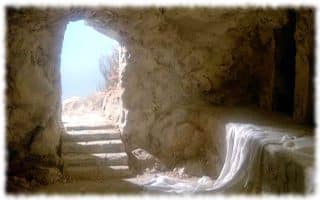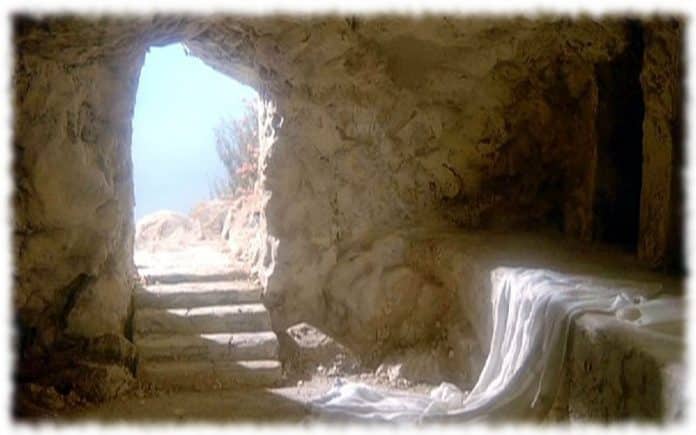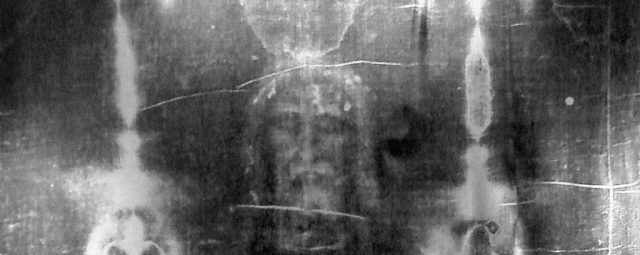You cannot prove life after death to anybody — the same way you cannot show them a radio wave.
 Either a person gets it or they don’t. Either they are tuned in to dimensions not visible in this material world, or they are not.
Either a person gets it or they don’t. Either they are tuned in to dimensions not visible in this material world, or they are not.
I once listened to a beautiful soundtrack of crickets. Crickets to our ears can be very annoying. But this recording was slowed down, and in the slowing down the din made by the crickets was transformed and became a choir. Everything sings. The universe is a symphony. We just cannot hear it in our dense and slow bodies.
Did Yeshua rise from the dead? Most definitely, as we all do. But not at the time or place or the manner in which we have been told. He did however, have a near death experience. And there is more than enough research on that subject should you wish to pursue it.
In the 1st century A.D. there was a conflict of opinion between the Sadducees and Pharisees on the one hand, and the Essenes on the other. The former totally rejected the concept of life after the death of the physical body, the latter, the Teachers of Righteousness, the Essenes, taught it to their students in Qumram, Mount Carmel and Damascus. These teachers then went out on three-year missions and taught the general population. At the end of their mission they either returned to their families, or returned to the Essene centres of learning to do further study and to teach younger students.
As a result, the early Christians who had been nurtured and were a creation of this group did not fear death at all, something the Roman Legions found to be most disconcerting and frustrating. It is difficult to enslave a people and control them when they are not afraid to die.
_________
Thirty years ago when I started this journey, I picked up a book called Who Moved The Stone? After reading it, I was none the wiser. It told me nothing. Like radio waves, I had the answer then, but I just could not see it.
What followed was a wild goose chase in pursuit of the truth and some real answers. Many other books researching all things Christian were to follow until my bookshelves were bursting at the seams. The answer is always so simple, we are the ones who complicate the issue.
For example, take a good hard look at the Shroud of Turin. What do you see? It is staring you in the face. This is not the shroud of Yeshua or anyone else for that matter. It is a stunning work of art, a portrait on cloth, and one thing tells you that implicitly. Either you see it, or you don’t.

Here is a close up:
The Gospel of John is one of my favourites. Try reading it with a sense of humor sometime. You will see things in a very different light. In each story that John tells, he punctuates it with a miracle, he even makes fun of the reader for needing miracles at all, but gives them to you anyway. His real message is interwoven with the magic but he expects you to think.
Which brings us to the miracle of the crucifixion.
_________
Central to the crucifixion story is a little spoken about character, Joseph of Arimathea. The little that we know about him was that he was the uncle of Yeshua. He was a trader and extremely well travelled. He had been as far afield as the British Isles and was familiar with the Silk Road leading into Persia and India. I have a strong suspicion that he was the father of Yeshua and not his uncle.
Yeshua in turn was a very well-educated and well-travelled man. His childhood had been spent in Egypt, studying in the great schools in Alexandria, many of which had been established when the Hebrews, the descendents of Ephraim and Manasseh, of the Northern Kingdom, first fled south during the Assyrian invasion and then fled the slavery that was imposed on them in Judea and crossed the Sinai into Egypt.
It is highly likely that Yeshua studied under such great philosophers as Philo and the Essene Therapeutia. He would also have been familiar with the Wisdom of Solomon written sometime in the 1st century B.C. which in chapters 2 & 3 describe the Righteous and their persecution by the unrighteous. It also describes life after death.
During the so-called lost years, it is believed that Yeshua travelled with Joseph where he studied at the various different schools both in the east and in the west. His education continued in the Essene schools at Qumram, Mount Carmel and Damascus until it was time for him to do his three-year teaching mission amongst the laity in Galilee, an area that once was part of the Northern Kingdom of Israel.
His studies would have included not only the Torah, but mathematics, astronomy and herbal medicine. Qumram as it was discovered in the last century was a treasure trove of literature that had been collected, copied and translated from many different texts.
By the time of the Last Supper, his three-year mission was complete, where according to our Gospels he was arrested, falsely accused of calling himself the king of the Jews, given a mistrial where he had no witnesses to speak on his behalf, and condemned to crucifixion.
Main Points of the Crucifixion, keeping in mind that the Essenes studied medicine and were great herbalists and healers, knowing the properties of different plants and how they could be used.
-
When Yeshua said that he was thirsty, he was given a sponge which was lifted to his mouth to drink. Thereafter he died, and some expressed surprise that he had died so quickly.
-
When the soldiers came to Yeshua they did not break his legs, they pierced his side with a spear.
-
Joseph of Arimathea and Nicodemus (who had previously argued with the Sadducees that a person on trial was entitled to witnesses to speak on their behalf and was mocked and asked if he also came from Galilee) took the body of Yeshua and placed it in Joseph’s tomb. It was the Sabbath and they wanted to put him in the tomb before sunset. Joseph approached Pontius Pilate and asked his permission to do this. Every man has his price and in all likelihood, a bag of gold changed hands.
What was in the sponge? We are told vinegar and hysop. Hysop is an expectorant used to clear mucus from the lungs. It is also a cough reliever and an antiseptic and stimulates the central nervous system. Vinegar is used to lower blood pressure, is an antiseptic and can also be used as a pain killer.
Conclusion: The mixture given to Yeshua lowered his blood pressure, cleared his lungs and in all likelihood contained a general anesthetic, such as benzine, which can either be obtained from crude oil or from benzine resin which is the gum from certain Styrax plants also known as frankincense.
Have you ever watch a stage show where the actor or actress plays dead? The biggest challenge is not only to breath as shallowly as possible so that it is not visible, but a coughing fit in the middle of the scene would ruin the effect entirely! Cough drops are an essential tool in any thespians box of tricks.
When the soldier pierced his side, there was a flow of blood and water. Once the heart stops beating the blood congeals. A person who is dead and whose heart has stopped beating will not bleed if cut or stabbed with a sharp object.
Conclusion: Yeshua was not dead. The mixture he had been given to drink lowered his blood pressure to the point where his heart was bearly beating and he was put into a deep unconscious state which gave the appearance of him being dead. When his side was pierced, he still bled, something that would not have happened if his heart had stopped beating and the blood in his veins and arteries had congealed.
Joseph of Arimathea and Nicodemus treated the body with a hundred pounds of myrrh and aloes. That is a lot of myrrh and aloes. Myrrh has many uses, one of which is a blood moving agent, it assists in keeping the circulation going, which would counteract the effects of the vinegar which lowered Yeshua’s blood pressure to the point where his circulation had been slowed down to a minium. Myrrh is also used to heal bruises, abrasions and sprains. Aloe vera is used to treat wounds.
Conclusion: Yeshua did not die and was treated by two highly trained physicians who attended to his wounds.
When Mary Magdalene arrived at the tomb on the first day, she found the stone moved, the tomb open, the linen that had wrapped his body lying in the sepulchre and two angels who asked her why she was weeping. These two angles were in all likelihood Joseph of Arimathea and Nicodemus who had tendered to his body and healed him.
She turned to find Yeshua in the garden but did not recognize him. Yeshua was known as a Nazarene. Part of the Nazarene laws (Numbers 6) are that at the end of their days of separation, which Yeshua spent in the tomb between the Friday at sunset and the Sunday at sunrise, was that they were to shave all their body hair and then they were to complete the ceremony under the guidance of the priest who would bless them. Mary does not recognize a bald headed Yeshua and he tells her not to touch him because he has not as yet ascended to this ceremony. The ceremony ends with the following prayer:
“The Lord bless thee and keep thee:
The Lord make his face shine upon thee and be gracious unto thee:
The Lord lift up his countenance upon thee, and give thee peace.”
Yeshua then joins the disciples that evening and the first thing he says to them is:
“Peace be unto you.”
Yeshua shows the disciples the wounds in his hands, feet and side. Lazarus had completed a similar Nazarite ceremony only a week prior to the arrest of Yeshua, but unlike Yeshua he had not suffered the indignity of arrest, an illegal trial or a crucifixion.
The objective of these rituals was to enter into a deep meditative state by separating themselves in order to achieve an out-of-body experience or the equivalent of an NDE. If you have seen the film Flatliners, it is a modern equivalent. Carl Sagan’s Contact, is a more high-tech version.
Yeshua’s next appearance was in Tiberius, and this is the last that John writes of him.
In John’s last chapter he makes fun of Peter who had denied Yeshua three times. He has Yeshua asking a confused Peter three times, “Do you love me?” Peter fails to make the connection between his three denials before the cock crowed and Yeshua’s question posed to him three times in a row when he reappeared to them in Tiberius.
The last chapter of John also suggests that Yeshua physically survived the cross. If he had not done so, why would he need the Beloved Disciple to look after him in his old age?
John ends his Gospel with the following:
“And there are also many other things which Jesus did, the which, if they should be written every one, I suppose that even the world itself could not contain the books that should be written. Amen.”
_________
So what happen to him after this? Here is one theory worth considering:
Jesus Christ: Was The Savior Buried In Kashmir, India? (emphasis mine)
According to the Roza Bal theory, Jesus lived until he was 80 years old in Kashmir, where he married and fathered several children. The Bible declared that Jesus ascended to heaven — Kashmir is known as “heaven on earth.” Moreover, many Kashmiris believe they are the descendants of one of the lost 10 tribes of Israel who fled the Assyrian occupation (suggesting that Jesus would seek refuge among his own people).
Katherine Frisk is a freelance writer, political commentator and author of Jesus Was A Palestinian.

Katherine Frisk is or was an enigma. We know that the amazing world-changing book, Jesus Was A Palestinian, was authored by a “Katherine Frisk” but there is NO other information on “Katherine Frisk”. We don’t even have an active email for her.
Many say that Katherine was Catherine “Kate” Frisk who was born in Malta in 1933 and lived in the USA where she passed away in 2018. But that’s NOT confirmed.
It may be that “Katherine Frisk” is a nom-de-plume. Considering the subject matter in our book, it would NOT be a stretch to imagine that some would take offense to her truth-telling and so going full anonymous would make survival sense. We simply don’t know. And so we cannot 100% confirm her identity.
What we do know is that Katherine submitted over 50 articles to VT and wrote a great book. That all stopped in 2018. VT periodically does a few re-publishes of her work.
ATTENTION READERS
We See The World From All Sides and Want YOU To Be Fully InformedIn fact, intentional disinformation is a disgraceful scourge in media today. So to assuage any possible errant incorrect information posted herein, we strongly encourage you to seek corroboration from other non-VT sources before forming an educated opinion.
About VT - Policies & Disclosures - Comment Policy





